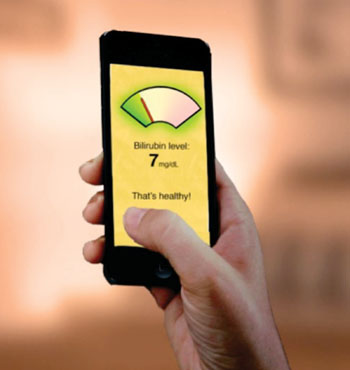Smartphone app Detects Neonatal Jaundice in Minutes
By HospiMedica International staff writers
Posted on 17 Sep 2014
A new smartphone app could serve as a screening tool to ascertain whether a baby needs a blood test to determine bilirubin levels. Posted on 17 Sep 2014
The BiliCam app, developed by researchers at the University of Washington (UW, Seattle, USA), evaluates a newborns skin tone relative to an included color calibration card (to account for different lighting conditions and skin tones). After capturing the data using the smartphone camera, the photo is sent to the cloud, where it is analyzed by machine-learning algorithms. The report on the newborn’s estimated bilirubin levels is delivered within minutes to doctors and parents.

Image: The BiliCam app reporting that bilirubin levels are normal (Photo courtesy of the University of Washington).
The UW researchers ran a clinical study with 100 newborns and their families at UW Medical Center, comparing the BiliCam to a standard blood test; the app performed as well as or better than the current screening tool. The researchers plan to test BiliCam on up to 1,000 additional newborns, especially those with darker skin pigments; the algorithms will then be robust enough to account for all ethnicities and skin colors. Though it would not replace a blood test, BiliCam could also become a useful tool in developing countries where jaundice accounts for many newborn deaths.
“Virtually every baby gets jaundiced, and we’re sending them home from the hospital even before bilirubin levels reach their peak,” said professor of pediatrics James Taylor, MD, medical director of the newborn nursery at UW Medical Center. “This smartphone test is really for babies in the first few days after they go home. A parent or health care provider can get an accurate picture of bilirubin to bridge the gap after leaving the hospital.”
“BiliCam would be a significantly cheaper and more accessible option than the existing reliable screening methods,” added Lilian de Greef, MSc, a UW doctoral student in computer science and engineering. “Lowering the access barrier to medical applications can have profound effects on patients, their caregivers, and their doctors, especially for something as prevalent as newborn jaundice.”
Neonatal jaundice is a yellowing of the skin and other tissues of a newborn infant as a result of a bilirubin level of more than 5 mg/dL. Jaundiced newborns have an apparent icteric sclera and yellowing of the face, extending down onto the chest. The condition affects 50%–60% of all babies in the first week of life. Prolonged hyperbilirubinemia can result into chronic bilirubin encephalopathy (kernicterus). Treatment includes phototherapy using a blue light at a wavelength of 420–448 nm, which oxidizes bilirubin to biliverdin.
Related Links:
University of Washington














